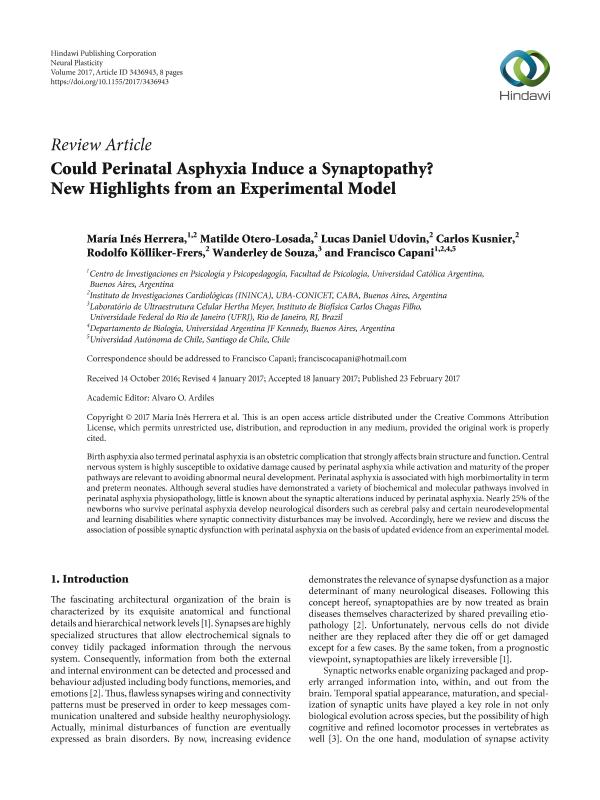Artículo
Could Perinatal Asphyxia Induce a Synaptopathy? New Highlights from an Experimental Model
Herrera, María Inés ; Otero-Losada, Matilde Estela
; Otero-Losada, Matilde Estela ; Udovin, Lucas Daniel; Kusnier, Carlos Federico
; Udovin, Lucas Daniel; Kusnier, Carlos Federico ; Kolliker Frers, Rodolfo Alberto
; Kolliker Frers, Rodolfo Alberto ; de Souza, Wanderley; Capani, Francisco
; de Souza, Wanderley; Capani, Francisco
 ; Otero-Losada, Matilde Estela
; Otero-Losada, Matilde Estela ; Udovin, Lucas Daniel; Kusnier, Carlos Federico
; Udovin, Lucas Daniel; Kusnier, Carlos Federico ; Kolliker Frers, Rodolfo Alberto
; Kolliker Frers, Rodolfo Alberto ; de Souza, Wanderley; Capani, Francisco
; de Souza, Wanderley; Capani, Francisco
Fecha de publicación:
02/2017
Editorial:
Hindawi Publishing Corporation
Revista:
Neural Plasticity
ISSN:
2090-5904
Idioma:
Inglés
Tipo de recurso:
Artículo publicado
Clasificación temática:
Resumen
Birth asphyxia also termed perinatal asphyxia is an obstetric complication that strongly affects brain structure and function. Central nervous system is highly susceptible to oxidative damage caused by perinatal asphyxia while activation and maturity of the proper pathways are relevant to avoiding abnormal neural development. Perinatal asphyxia is associated with high morbimortality in term and preterm neonates. Although several studies have demonstrated a variety of biochemical and molecular pathways involved in perinatal asphyxia physiopathology, little is known about the synaptic alterations induced by perinatal asphyxia. Nearly 25% of the newborns who survive perinatal asphyxia develop neurological disorders such as cerebral palsy and certain neurodevelopmental and learning disabilities where synaptic connectivity disturbances may be involved. Accordingly, here we review and discuss the association of possible synaptic dysfunction with perinatal asphyxia on the basis of updated evidence from an experimental model.
Palabras clave:
Perinatal Asphixia
,
Synapsis
,
Neural Development
,
Synaptic Dysfunction
Archivos asociados
Licencia
Identificadores
Colecciones
Articulos(ININCA)
Articulos de INST.DE INVEST.CARDIOLOGICAS (I)
Articulos de INST.DE INVEST.CARDIOLOGICAS (I)
Citación
Herrera, María Inés; Otero-Losada, Matilde Estela; Udovin, Lucas Daniel; Kusnier, Carlos Federico; Kolliker Frers, Rodolfo Alberto; et al.; Could Perinatal Asphyxia Induce a Synaptopathy? New Highlights from an Experimental Model; Hindawi Publishing Corporation; Neural Plasticity; 2017; 2-2017; 1-8
Compartir
Altmétricas



